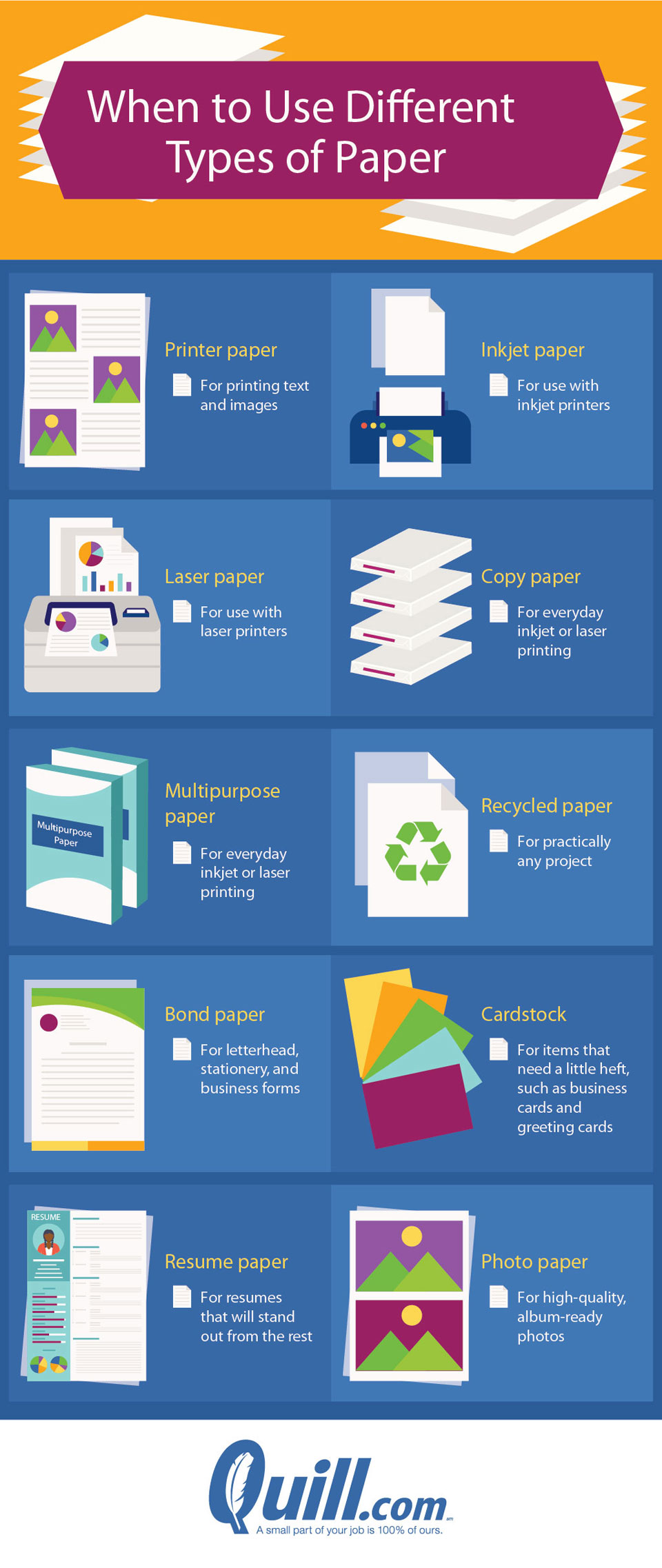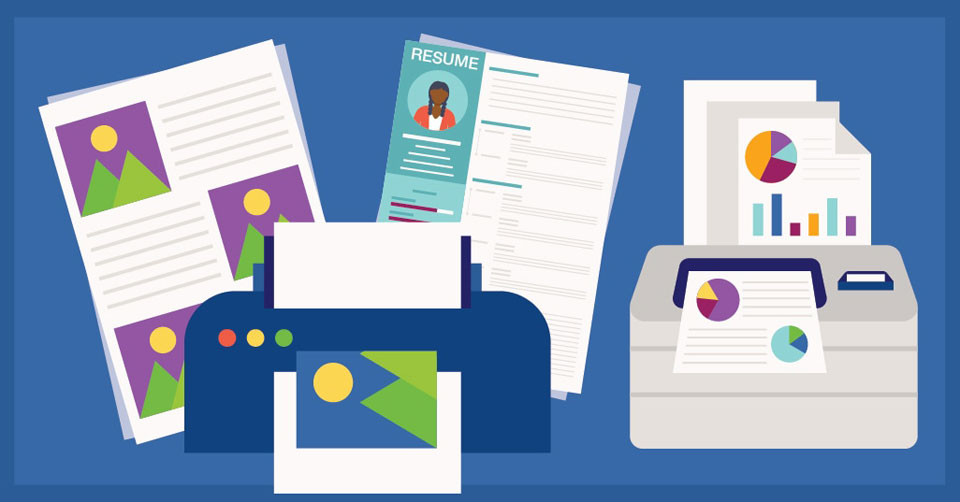Are you using the right paper for your project? Not sure what might be the better fit for your needs? If you’re in a hurry, check out how different types of paper stack up against one another. Select the papers you’d like to compare:


Are you using the right paper for your project? Not sure what might be the better fit for your needs? If you’re in a hurry, check out how different types of paper stack up against one another. Select the papers you’d like to compare:

When it comes to laser printer paper versus inkjet paper, it boils down to absorbability and printing technology. If you're using an inkjet printer, you need paper labeled for use in an inkjet printer. Why? Because this type of paper is specially made to absorb the liquid ink used in the printing process.
On the flip side, paper suitable for laser printers is made to withstand heat. Laser printers use a colored powder called toner to imprint words and images on the page. The printer's fuser rollers help to fuse this powder to the page with heat, which produces beautiful, vibrant images.
To produce the clearest possible copy and images, use the paper that corresponds to the type of printer you have. While you should never use laser printer paper in an inkjet printer and vice versa, you can use multipurpose or copy paper in either machine. Copy paper can be used for a variety of purposes because it is made to withstand the rigors of different printers.
Historically, bond paper (also known as text weight paper) was made with cotton rags, and government bonds were printed on it. Now it is used for all-purpose document printing, such as for stationery, fliers, letters, and brochures. This paper, which is available in several weights and different types of perforation, is not nearly as thick as cardstock. Bond paper is typically more durable than multipurpose paper.
Cardstock also comes in a variety of paper sizes and weights, but even the lightest weight cardstock is thicker than even the thickest bond paper. This beefy paper product is best suited for business cards and paperback book covers.
Copy paper is slightly thinner and less expensive than printer paper. When printing documents with text, you can use the two interchangeably. It won't make much of a difference beyond the amount of light that passes through each sheet of paper, which depends on the weight.
However, when printing pages with a lot of images, opt for the thicker printer paper. Printing on non-printer paper can leave you with a heavily saturated, slightly wet look with less crisp images. You also wouldn't want to use these printing papers for items that need a little heft, such as business cards.
There is no difference between multipurpose paper and copy paper. This economical option is best for printing text-based documents in a variety of sizes, from the ubiquitous letter size to legal size. For a step up, you can purchase premium multipurpose paper, which can be higher quality.
Non-recycled paper, sometimes called virgin paper, refers to paper made from all new materials such as wood pulp or cotton.
According to the International Organization of Standardization (ISO), recycled paper can be made from pre-consumer material and post-consumer material.
Recycled paper can also be called post-consumer paper. The Federal Trade Commission (FTC) has strict guidelines for what it deems recycled: “A paper can be called recycled only if it contains 100 percent post-consumer recovered fiber. If the post-consumer content is less than 100 percent, the paper should be called recycled-content paper.” Recycled-content paper can range from 30 to 80 percent or more of recycled content.
There's no right or wrong time to use recycled paper. One instance where you may want to use recycled or recycled-content paper is when a Request for Proposal (RFP) requires it. Some government agencies request that respondents to RFPs submit proposals on recycled paper to encourage eco-friendly practices. It's also a good idea to create a paper recycling protocol at home and work to maintain the process.
When it comes to the cost of recycled versus regular paper, you'll find that recycled versions often are more expensive thanks to supply and demand (there's usually a much greater demand for new paper). Plus, it costs more to process recycled paper because many paper mills have been built to process virgin paper, and processing recycled paper requires a different process.
Inkjet paper has a tighter weave that prevents bleed-through from the liquid ink that imprints text and images onto the page. Plain paper is often untreated and does not have as fine a weave. If you make the mistake of using plain paper in an inkjet printer, you may end up with a soggy sheet and bleed through.
Copy paper encompasses a wide range of multipurpose paper. It can be used in laser or inkjet printers as well as copiers and fax machines. Typically, all-purpose copy paper is made to accommodate different types of technology and multiple machines.
By contrast, inkjet paper is a type of copy paper that is specially formulated for inkjet printers. While it can withstand wet sprays of ink, it isn't suitable for laser printers which require coated paper.
Laser paper is another type of copy paper. It is specially treated to withstand the high heat used to fuse words and images to the page. In a pinch, copy paper can stand in for laser paper.
In the most traditional sense of the term, resume paper is a type of bond paper. Before the internet, many job applicants went out of their way to print on a special type of paper—made with cotton or linen fibers—that helped their resume stand out among the crowd. Today, many people make their first impression with an online resume so you can often forgo fancy paper (though many experts say you should have both).
Technically, modern vellum is a type of bond paper: Both may be made with cotton fiber. However, the two types of paper are vastly different.
Historically, vellum was made from processed calfskin. This type of vellum (known as true vellum) was very thin and translucent. Official documents, such as the Magna Carta, were printed on true vellum to preserve them. They also had to be stored in a temperature-controlled environment. Modern vellum is made from a type of sheer cotton treated with plastic. It's more transparent than true vellum. Modern vellum is most commonly used as a pretty overlay on wedding invitations and other decorative projects.
Bond paper can also be a type of inkjet paper, so long as it's treated properly. When you print using an inkjet printer, you need to use paper that can absorb ink without saturating the page, which then causes ugly puckering on documents or images. Bond paper's thicker, more absorbent construction lends itself to this purpose.
When you hear the term “inkjet paper,” you may think of thinner 20- to 24 lb.-weight paper used to print documents or graphic presentations. However, this term refers to any paper that is designed to accommodate inkjet printers.
Photo paper can be a type of inkjet paper too, as long as it's specially formulated to work with inkjet printers to produce beautiful, album-quality photos you can print right from your home office. You can choose from matte or glossy photo paper.
If you want to print a greeting card or business card, stick with the type of paper that has “card” in its name. Cardstock is universally thicker than copy paper. Depending on the weight, cardstock can be thinner and more flexible (such as a thin paperback book cover), or slightly more rigid (resembling a high-quality business card or a greeting card). Copy paper is only suitable for printing documents.
When it comes to the brightness of copy paper, the higher the number, the brighter. For instance, paper with a level 98 brightness is bright white, while 96 brightness is just slightly less bright, and 92 brightness is even less bright.
While it's one of the most common office supplies, paper is more complex than you may think. Whether you're looking to print a resume, photos, or a stack of business cards, use this information to guide your next paper purchase.
Quill help center
New to Quill? Would you like to learn more about how we can help your business?